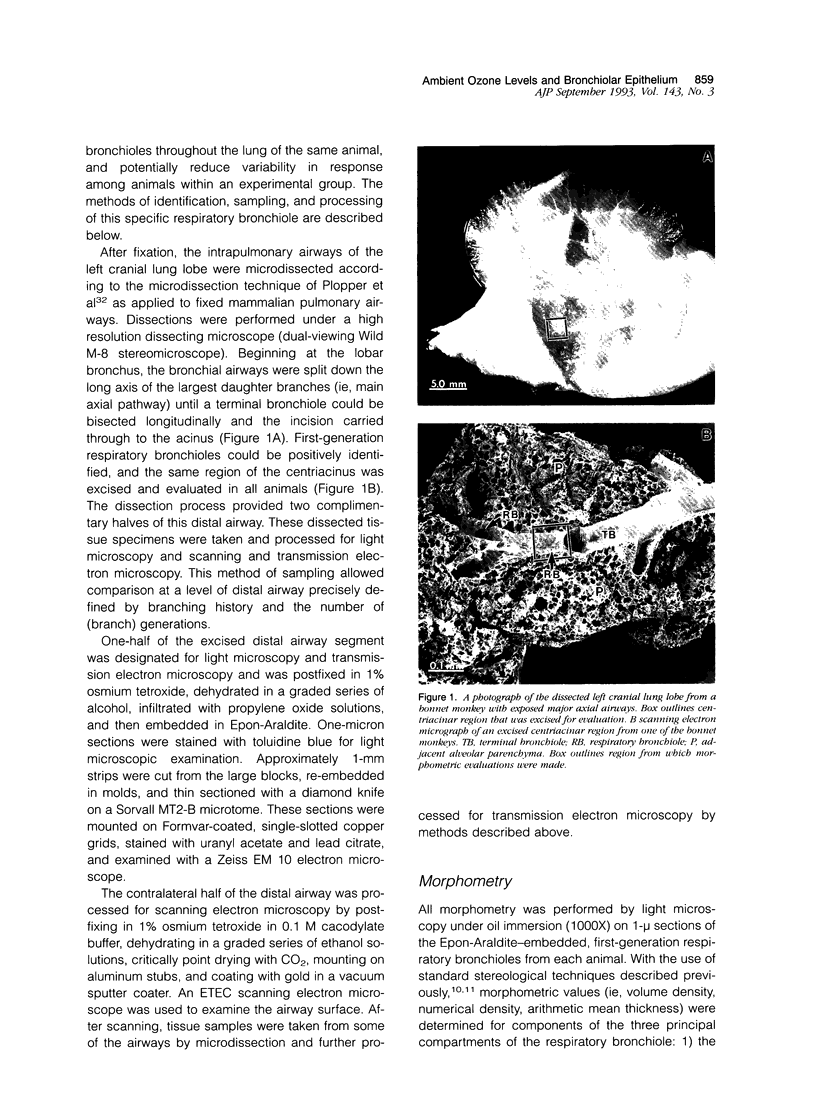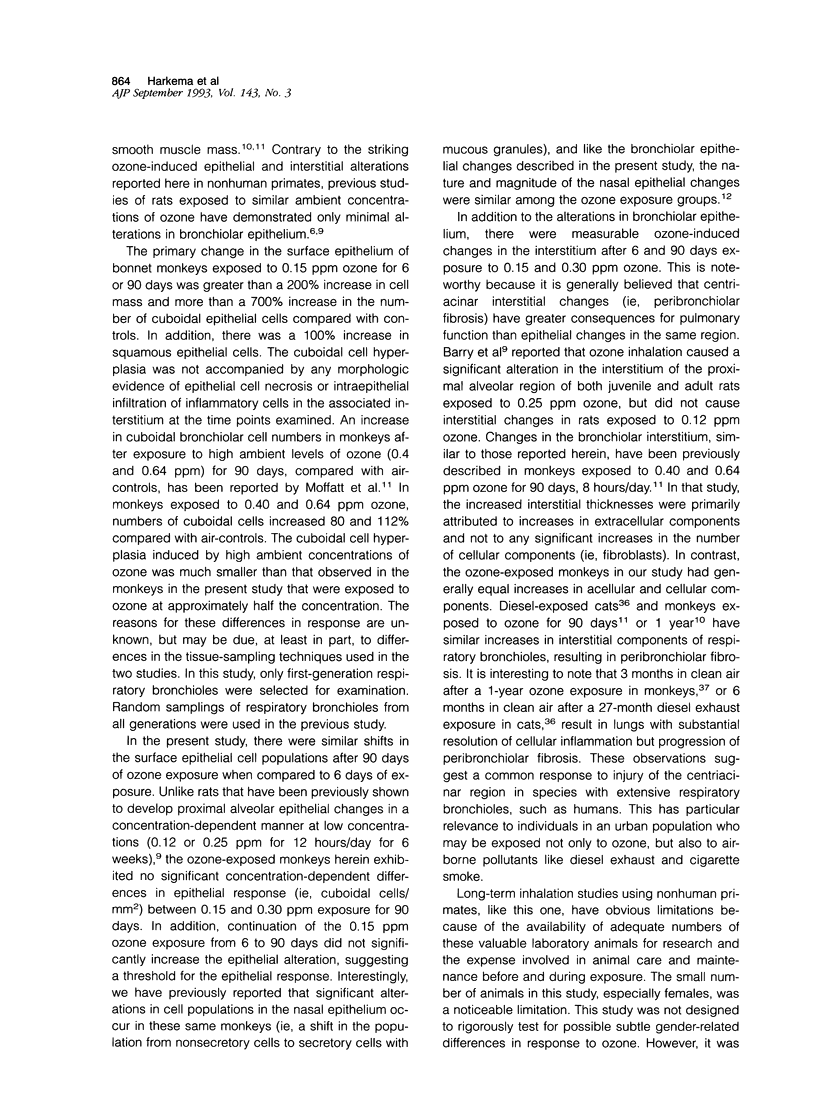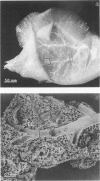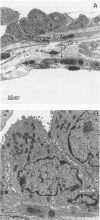Abstract
Recently, we reported that exposure to ambient concentrations of ozone, near the U.S. National Ambient Air Quality Standard (0.12 ppm), induced significant nasal epithelial lesions in a non-human primate, the bonnet monkey. The present study defines the effects of ambient concentrations of ozone on the surface epithelium lining respiratory bronchioles and on the underlying bronchiolar interstitium in these same monkeys. Bonnet monkeys were exposed to filtered air or to 0.15 or 0.30 ppm ozone 8 hours/day for 6 or 90 days. At the end of exposures, monkeys were anesthetized and killed by exsanguination. Microdissected bronchiolar airways of infusion-fixed lungs were evaluated morphometrically by light microscopy and quantitatively by scanning and transmission electron microscopy for ozone-induced epithelial changes. Hyperplasia of nonciliated, cuboidal epithelial cells and intraluminal accumulation of macrophages characterized ozone-induced lesions in respiratory bronchioles. There were no significant differences in epithelial thickness or cell numbers among ozone-exposed groups. Ozone-exposed epithelium was composed of 80% cuboidal and 20% squamous cells compared with 40% cuboidal and 60% squamous cells in filtered air controls. In addition, the arithmetic mean thickness of the surface epithelium, a measure of tissue mass per unit area of basal lamina, was significantly increased in all of the ozone-exposed groups. The number of cuboidal epithelial cells per surface area of basal lamina was increased above control values by 780% after 6 days exposure to 0.15 ppm, 777% after 90 days to 0.15 ppm, and 996% after 90 days exposure to 0.30 ppm. There was also a significant ozone-induced increase in the thickness of the bronchiolar interstitium that was due to an increase in both cellular and acellular components. These results demonstrate that exposure to low ambient concentrations of ozone, near the current. National Ambient Air Quality Standard, induces pulmonary lesions in primates. The alterations do not appear to be concentration- or time-dependent, suggesting that the current National Ambient Air Quality Standard may be at or above the threshold for deep lung injury in primates.
Full text
PDF









Images in this article
Selected References
These references are in PubMed. This may not be the complete list of references from this article.
- Avol E. L., Linn W. S., Shamoo D. A., Valencia L. M., Anzar U. T., Venet T. G., Hackney J. D. Respiratory effects of photochemical oxidant air pollution in exercising adolescents. Am Rev Respir Dis. 1985 Sep;132(3):619–622. doi: 10.1164/arrd.1985.132.3.619. [DOI] [PubMed] [Google Scholar]
- Avol E. L., Linn W. S., Venet T. G., Shamoo D. A., Hackney J. D. Comparative respiratory effects of ozone and ambient oxidant pollution exposure during heavy exercise. J Air Pollut Control Assoc. 1984 Aug;34(8):804–809. doi: 10.1080/00022470.1984.10465814. [DOI] [PubMed] [Google Scholar]
- Barr B. C., Hyde D. M., Plopper C. G., Dungworth D. L. Distal airway remodeling in rats chronically exposed to ozone. Am Rev Respir Dis. 1988 Apr;137(4):924–938. doi: 10.1164/ajrccm/137.4.924. [DOI] [PubMed] [Google Scholar]
- Barry B. E., Miller F. J., Crapo J. D. Effects of inhalation of 0.12 and 0.25 parts per million ozone on the proximal alveolar region of juvenile and adult rats. Lab Invest. 1985 Dec;53(6):692–704. [PubMed] [Google Scholar]
- Boorman G. A., Schwartz L. W., Dungworth D. L. Pulmonary effects of prolonged ozone insult in rats. Morphometric evaluation of the central acinus. Lab Invest. 1980 Aug;43(2):108–115. [PubMed] [Google Scholar]
- Calderon-Garcidueñas L., Osorno-Velazquez A., Bravo-Alvarez H., Delgado-Chavez R., Barrios-Marquez R. Histopathologic changes of the nasal mucosa in southwest Metropolitan Mexico City inhabitants. Am J Pathol. 1992 Jan;140(1):225–232. [PMC free article] [PubMed] [Google Scholar]
- Castleman W. L., Dungworth D. L., Schwartz L. W., Tyler W. S. Acute respiratory bronchiolitis: an ultrastructural and autoradiographic study of epithelial cell injury and renewal in rhesus monkeys exposed to ozone. Am J Pathol. 1980 Mar;98(3):811–840. [PMC free article] [PubMed] [Google Scholar]
- Fujinaka L. E., Hyde D. M., Plopper C. G., Tyler W. S., Dungworth D. L., Lollini L. O. Respiratory bronchiolitis following long-term ozone exposure in bonnet monkeys: a morphometric study. Exp Lung Res. 1985;8(2-3):167–190. doi: 10.3109/01902148509057520. [DOI] [PubMed] [Google Scholar]
- Gibbons S. I., Adams W. C. Combined effects of ozone exposure and ambient heat on exercising females. J Appl Physiol Respir Environ Exerc Physiol. 1984 Aug;57(2):450–456. doi: 10.1152/jappl.1984.57.2.450. [DOI] [PubMed] [Google Scholar]
- Gong H., Jr, Bradley P. W., Simmons M. S., Tashkin D. P. Impaired exercise performance and pulmonary function in elite cyclists during low-level ozone exposure in a hot environment. Am Rev Respir Dis. 1986 Oct;134(4):726–733. doi: 10.1164/arrd.1986.134.4.726. [DOI] [PubMed] [Google Scholar]
- Harkema J. R., Hotchkiss J. A., Henderson R. F. Effects of 0.12 and 0.80 ppm ozone on rat nasal and nasopharyngeal epithelial mucosubstances: quantitative histochemistry. Toxicol Pathol. 1989;17(3):525–535. doi: 10.1177/019262338901700307. [DOI] [PubMed] [Google Scholar]
- Harkema J. R., Plopper C. G., Hyde D. M., St George J. A., Wilson D. W., Dungworth D. L. Response of the macaque nasal epithelium to ambient levels of ozone. A morphologic and morphometric study of the transitional and respiratory epithelium. Am J Pathol. 1987 Jul;128(1):29–44. [PMC free article] [PubMed] [Google Scholar]
- Kulle T. J., Sauder L. R., Hebel J. R., Chatham M. D. Ozone response relationships in healthy nonsmokers. Am Rev Respir Dis. 1985 Jul;132(1):36–41. doi: 10.1164/arrd.1985.132.1.36. [DOI] [PubMed] [Google Scholar]
- Linn W. S., Avol E. L., Shamoo D. A., Spier C. E., Valencia L. M., Venet T. G., Fischer D. A., Hackney J. D. A dose-response study of healthy, heavily exercising men exposed to ozone at concentrations near the ambient air quality standard. Toxicol Ind Health. 1986 Jul;2(1):99–112. doi: 10.1177/074823378600200105. [DOI] [PubMed] [Google Scholar]
- Lioy P. J., Vollmuth T. A., Lippmann M. Persistence of peak flow decrement in children following ozone exposures exceeding the National Ambient Air Quality Standard. J Air Pollut Control Assoc. 1985 Oct;35(10):1069–1071. [PubMed] [Google Scholar]
- McDonnell W. F., 3rd, Chapman R. S., Leigh M. W., Strope G. L., Collier A. M. Respiratory responses of vigorously exercising children to 0.12 ppm ozone exposure. Am Rev Respir Dis. 1985 Oct;132(4):875–879. doi: 10.1164/arrd.1985.132.4.875. [DOI] [PubMed] [Google Scholar]
- McDonnell W. F., Horstman D. H., Hazucha M. J., Seal E., Jr, Haak E. D., Salaam S. A., House D. E. Pulmonary effects of ozone exposure during exercise: dose-response characteristics. J Appl Physiol Respir Environ Exerc Physiol. 1983 May;54(5):1345–1352. doi: 10.1152/jappl.1983.54.5.1345. [DOI] [PubMed] [Google Scholar]
- Mercer R. R., Anjilvel S., Miller F. J., Crapo J. D. Inhomogeneity of ventilatory unit volume and its effects on reactive gas uptake. J Appl Physiol (1985) 1991 May;70(5):2193–2205. doi: 10.1152/jappl.1991.70.5.2193. [DOI] [PubMed] [Google Scholar]
- Moffatt R. K., Hyde D. M., Plopper C. G., Tyler W. S., Putney L. F. Ozone-induced adaptive and reactive cellular changes in respiratory bronchioles of bonnet monkeys. Exp Lung Res. 1987;12(1):57–74. doi: 10.3109/01902148709068814. [DOI] [PubMed] [Google Scholar]
- Pinkerton K. E., Mercer R. R., Plopper C. G., Crapo J. D. Distribution of injury and microdosimetry of ozone in the ventilatory unit of the rat. J Appl Physiol (1985) 1992 Sep;73(3):817–824. doi: 10.1152/jappl.1992.73.3.817. [DOI] [PubMed] [Google Scholar]
- Plopper C. G., Chow C. K., Dungworth D. L., Tyler W. S. Pulmonary alterations in rats exposed to 0.2 and 0.1 ppm ozone: a correlated morphological and biochemical study. Arch Environ Health. 1979 Nov-Dec;34(6):390–395. doi: 10.1080/00039896.1979.10667438. [DOI] [PubMed] [Google Scholar]
- Plopper C. G., Hyde D. M., Weir A. J. Centriacinar alterations in lungs of cats chronically exposed to diesel exhaust. Lab Invest. 1983 Oct;49(4):391–399. [PubMed] [Google Scholar]
- Plopper C. G., Mariassy A. T., Lollini L. O. Structure as revealed by airway dissection. A comparison of mammalian lungs. Am Rev Respir Dis. 1983 Aug;128(2 Pt 2):S4–S7. doi: 10.1164/arrd.1983.128.2P2.S4. [DOI] [PubMed] [Google Scholar]
- Schwartz L. W., Dungworth D. L., Mustafa M. G., Tarkington B. K., Tyler W. S. Pulmonary responses of rats to ambient levels of ozone: effects of 7-day intermittent or continuous exposure. Lab Invest. 1976 Jun;34(6):565–578. [PubMed] [Google Scholar]
- Spektor D. M., Lippmann M., Lioy P. J., Thurston G. D., Citak K., James D. J., Bock N., Speizer F. E., Hayes C. Effects of ambient ozone on respiratory function in active, normal children. Am Rev Respir Dis. 1988 Feb;137(2):313–320. doi: 10.1164/ajrccm/137.2.313. [DOI] [PubMed] [Google Scholar]
- Spektor D. M., Lippmann M., Thurston G. D., Lioy P. J., Stecko J., O'Connor G., Garshick E., Speizer F. E., Hayes C. Effects of ambient ozone on respiratory function in healthy adults exercising outdoors. Am Rev Respir Dis. 1988 Oct;138(4):821–828. doi: 10.1164/ajrccm/138.4.821. [DOI] [PubMed] [Google Scholar]
- Tyler W. S. Comparative subgross anatomy of lungs. Pleuras, interlobular septa, and distal airways. Am Rev Respir Dis. 1983 Aug;128(2 Pt 2):S32–S36. doi: 10.1164/arrd.1983.128.2P2.S32. [DOI] [PubMed] [Google Scholar]
- Tyler W. S., Tyler N. K., Last J. A., Gillespie M. J., Barstow T. J. Comparison of daily and seasonal exposures of young monkeys to ozone. Toxicology. 1988 Jul;50(2):131–144. doi: 10.1016/0300-483x(88)90086-8. [DOI] [PubMed] [Google Scholar]






